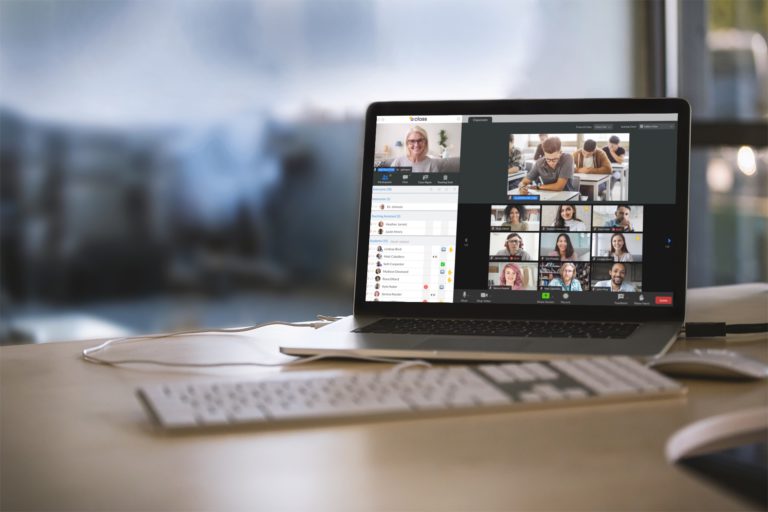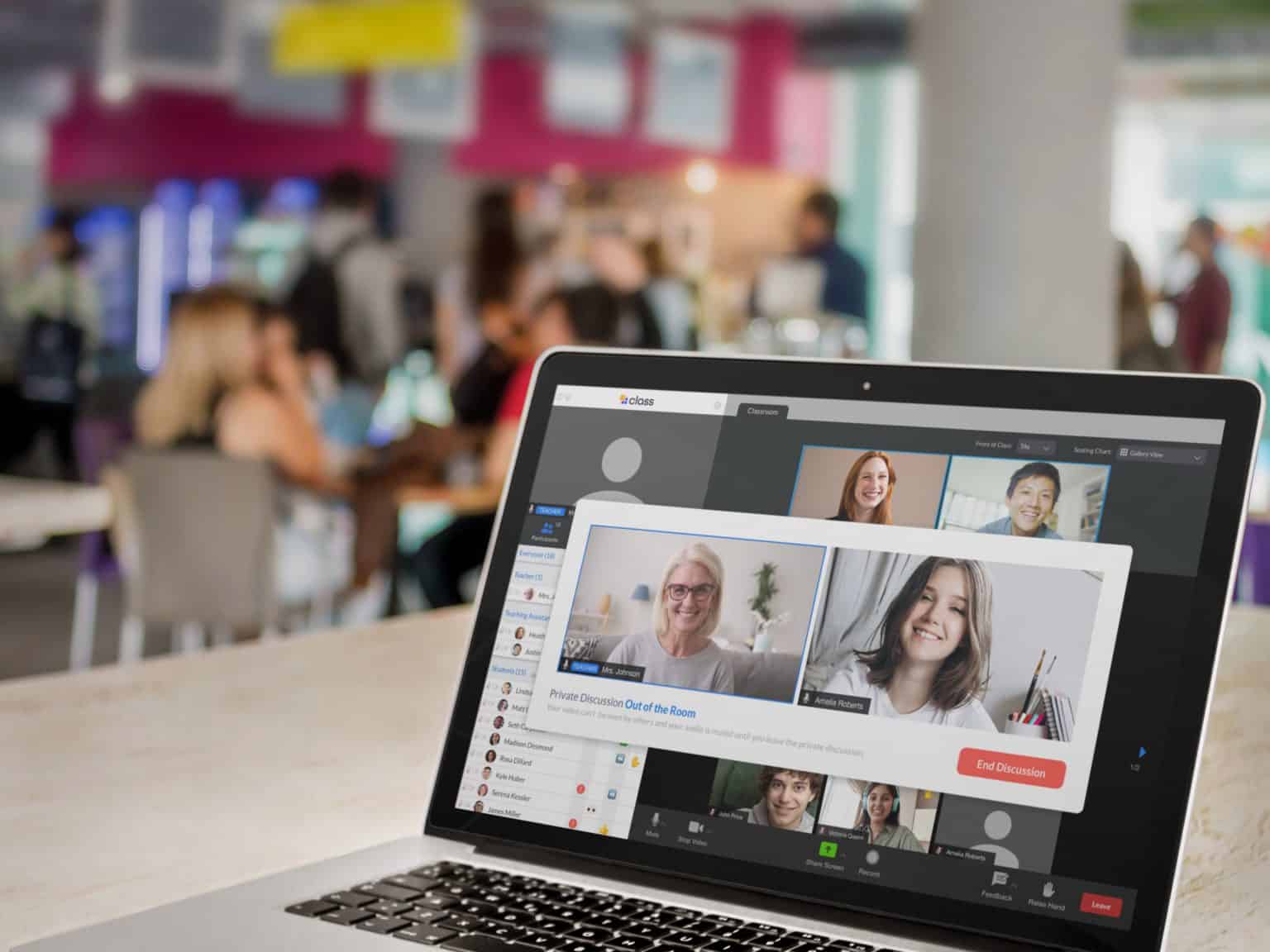
Class is the next generation virtual classroom for K-12, higher education, government agencies, and the workplace. Contact us today to schedule your live demo and see Class in action.

Class is the next generation virtual classroom for K-12, higher education, government agencies, and the workplace. Contact us today to schedule your live demo and see Class in action.

With over a year of teaching in a new virtual, or hybrid, classroom environment under their belts, teachers have learned a lot about how to create hybrid lesson plans to accommodate the “new normal” while effectively connecting and engaging with students.
Whether teaching all live courses on some days and all virtual on others, or splitting students so that some are in class and others online, it’s fair to say that this has definitely been an adjustment for all involved. But, as the spring semester gets underway, teachers are feeling more confident about their virtual and hybrid learning classroom management skills. They’re incorporating a number of lessons learned and best practices of hybrid lesson plans to get a leg up this semester.
One of the things that many teachers have learned is what doesn’t work.
Arash Fayz is executive director of LA Tutors 123, a test preparation, academic consulting and tutoring company based in Los Angeles. “One of the most important things I’ve learned about lesson planning for hybrid classrooms is that educators need to be flexible and recognize that classes cannot be treated exactly like in-person learning,” Fayz says. “The lesson plans I’ve seen kids struggle with the most are the ones that simply seem copy-and-pasted from an in-person curriculum.”
Fayz points out that teachers need to recognize that some of the ways that students learned in-person (talking with peers after class, showing a teacher their work during class, picking up on tone or body language to get context, etc.) are much more difficult when online or doing self-directed work. “Teachers need to be more patient and have more check-ins along the way,” he says. Shy or reluctant students may need even more reinforcement, he says, as they may be even less willing to speak up during Zoom classroom sessions.
Instead, when moving to a hybrid environment, teachers at all levels need to think differently about how they will interact with and engage students. Many have learned through trial, error and experimentation what works best.

Nadia Ibrahim-Taney is a university career coach and lecturer teaching students how to get hired and be successful in the professional workplace. Teaching hasn’t changed much over the past 100 years, she says, but it’s certainly changing now.
“What we are seeing is a move towards cooperative education and learning in the classroom meaning students are learning from peers, through guest speakers, or outside classroom sources like podcasts or hands-on experience through internships,” Ibrahim-Taney says.
With the shift to a virtual or hybrid learning environment, Ibrahim-Taney says that she has stopped “lecturing to my students.” Instead, she says, she creates recorded lectures and reserves live classroom time for activities, conversation and collaboration.
Her hybrid teaching strategies include consideration of students’ wellbeing and mental health. “I make it a point to incorporate check-ins and mental-health focused activities into my lesson plan because as much as I am teaching my students how to do something, I want to give them the space to feel safe and supported.”
Michael Garbade is the founder of Ledu Education Ecosystem, a learning ecosystem for future technology topics. “What I have learned from the experience of teaching hybrid classrooms is that engaging in small group and individual discussions with the students helps me a lot in making a lesson plan for a hybrid classroom,” says Garbade. He says he’s noticed that discussions help both him and his students get to know each other better. He seeks feedback from students about how he can make the hybrid classroom and the learning environment more effective. “It allows me to know them personally and give and get in-person feedback,” he says. “The students also get personalized support to improve their concentration and learning during a hybrid class.
Good hybrid classroom lessons will have built-in check-ins, breakout rooms, and even one-on-one tutoring sessions even if they’re very brief, says Fayz. For hybrid classrooms, he recommends:
All of the adjustments and experimentation with hybrid teaching strategies seem to be paying off for many teachers who are finding that hybrid teaching can really work well.

Ibrahim-Taney, for example, says that her new approaches for engaging students in hybrid teaching settings are paying off. “My students are more consistently attending classes, more engaged, talkative and social with me and their peers,” she says. “I honestly because they are learning more and having fun actually doing it even with the challenges of virtual environments.”
Ibrahim-Taney’s advice for other teachers is to “be flexible and open to new ways of connecting with your students and connecting students to your content.” Students, she says, “want engagement, not sitting and listening to lectures and reading academic textbooks.” While this is still part of the experience, it shouldn’t, she says, be the entire experience.
Matthew Wright, PhD, is an associate professor and chair of the physics department at Adelphi University in New York. Last year wasn’t a good year, says Wright, who adds that “2021 hasn’t started off too hot either.” Teaching in this environment, he says, is difficult. To cope, he says: “The number one and number two rules I have learned from teaching during the pandemic is to be flexible and continuously engage students.”
Wright points out that students have other things going on besides their classroom activities. Recognizing the different walks of life and responsibilities they have, he says he tries to be as flexible as possible and offer multiple options when he can. Hybrid lesson plans shouldn’t just be focused on course content, he says. “It is important to take time and talk to each student, if possible, to find out where they are.”
“Give them as many opportunities as possible for them to share their situations with you so you can help them out,” Wright advises.
Need additional ideas for developing your own hybrid lesson plans? It can be helpful to view other teachers’ lesson plan examples. There are many available online. A quick Google search for “hybrid lesson plan examples,” for instance, pulls up more than 34 million results including a variety of templates that can easily be adapted and adopted by teachers at all levels of education.

Class is the next generation virtual classroom for K-12, higher education, government agencies, and the workplace. Contact us today to schedule your live demo and see Class in action.

Class is the next generation virtual classroom for K-12, higher education, government agencies, and the workplace. Contact us today to schedule your live demo and see Class in action.
Get our insights, tips, and best practices delivered to your inbox

Sign up for a product demo today to learn how Class’s virtual classroom powers digital transformation at your organization.

Features
Products
Integrations